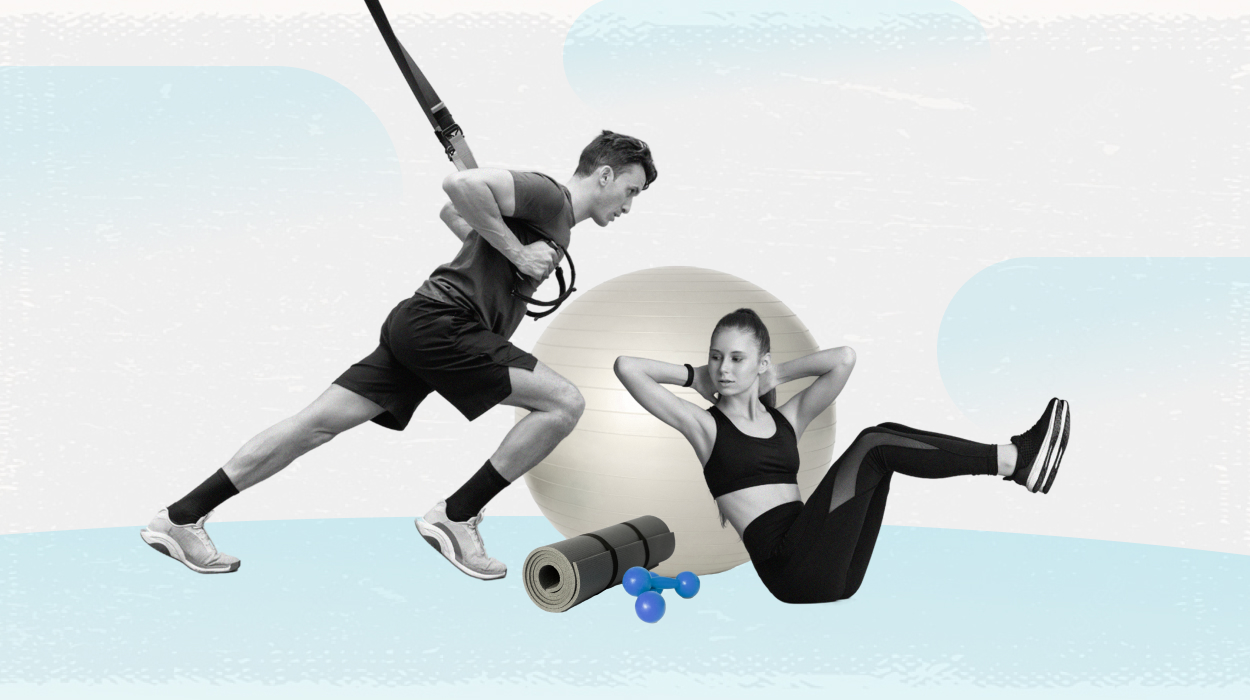
You came here for the hardest ab exercises. You don’t need us to tell you that these exercises will give you the best workout for core and abs you’ve ever seen. They can also help you burn fat – better and cheaper than a commercial fat burner – and build a strong core.
This article will explore seven of the most challenging muscle-building ab exercises that will push your rigid body line limits and take your fitness journey to the next level. Before we start, note that you’ll get the best and safest results with proper form and technique.
Hardest Ab Exercises You May Not Know
Here are some abdominal exercises that are sure to give you a challenge:
Hardest Ab Exercises To Challenge
Step into the realm of intense core workouts. These advanced exercises are designed to test your abdominal strength and endurance, pushing you to achieve new fitness heights.
Dragon Flag
The Dragon Flag is an exercise known for engaging the entire core and building incredible abdominal strength. It requires a high level of control and stability, making it one of the hardest ab exercises.
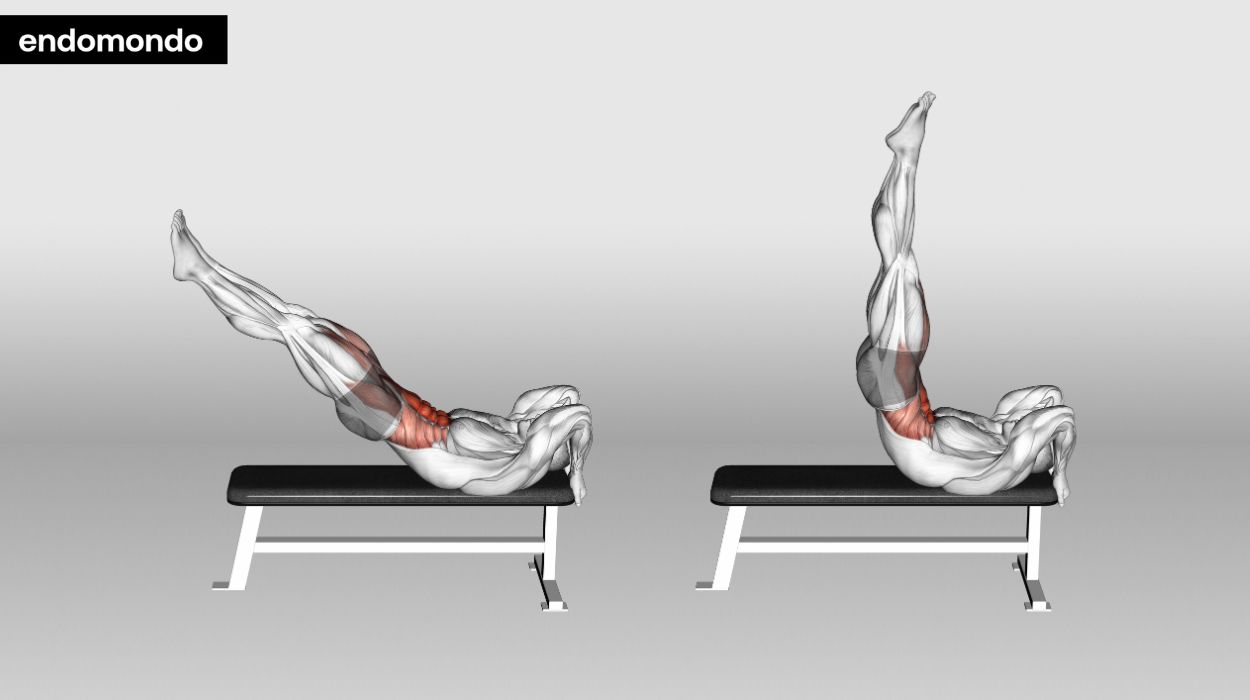
How to do:
- Lie on your back on a flat bench or mat with your upper body extended and your hands gripping the bench behind your head.
- Lift your legs and hips off the bench, keeping your body fixed and straight but your knees bent.
- Slowly lower your legs and hips toward the bench, maintaining control throughout the movement.
- Once your legs are parallel to the bench, reverse the movement and lift your legs and hips back to the starting position.
Tips:
- Ensure your shoulder blades and upper back are firmly planted on the bench or surface to maintain stability.
- Keep your neck relaxed and avoid straining it by looking straight up; instead, focus on a point above you.
- Progress gradually and listen to your body; avoid overextending or pushing beyond your current strength level.
Optimal Sets and Reps: 3 sets of 8-10 repetitions.
Standing Barbell Rollout
The Standing Barbell Rollout is a challenging hardest ab exercise of standing ab rollouts that targets the entire core, including the rectus abdominis, obliques, and lower back muscles. This exercise requires a barbell with weight plates.
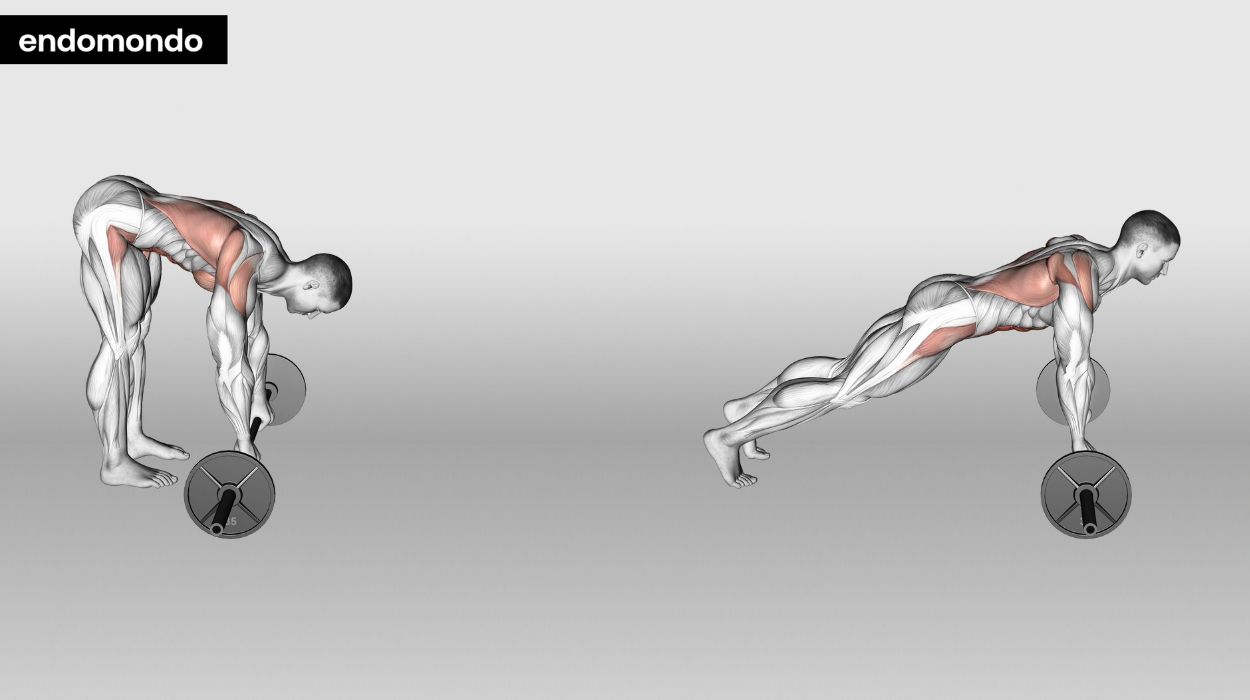
How to do:
- Stand upright with your feet shoulder-width apart, knees slightly bent, holding a barbell with an overhand grip. Your hands should be slightly wider than shoulder-width apart, and the barbell will be resting on your upper thighs.
- Bring the barbell to the floor and slowly roll it forward, keeping your core engaged and your back straight.
- Continue rolling until your entire body is fully extended, with your arms overhead and your torso parallel to the floor.
- Reverse the movement by pulling the barbell back towards your body, returning to the start standing position.
Tips:
- Maintain a straight line from your head to your hips as you roll the barbell out and back in.
- Control the movement and avoid using momentum to roll the barbell; focus on your core strength.
- Perform the exercise on a non-slip surface or with appropriate footwear to ensure stability and safety.
Optimal Sets and Reps: 3 sets of 8-10 repetitions per side.
TRX Oblique Crunch
The TRX Oblique Crunch is an intense exercise that targets the obliques, the muscles on the sides of your abdomen. It requires a TRX suspension trainer or any other suitable suspension training system.
How to do:
- Place your feet in the handles of the TRX suspension trainer and get into a plank position with your arms straight.
- Inhale and brace your core as you bring your knees up toward your chest and to one side.
- Hold here momentarily before exhaling and slowly straightening your legs back out.
Tips:
- Ensure the TRX straps are securely anchored and at chest height to avoid accidents.
- Keep your head aligned with your spine, avoiding neck strain by looking straight ahead or slightly upward.
- Adjust the angle of your body to the TRX straps to increase or decrease the exercise’s difficulty, depending on your fitness level.
Optimal Sets and Reps: 3 sets of 10-12 repetitions per side.
Hanging Dragonflies
The Hanging Dragonflies are an advanced hanging leg exercise that targets the abdominal muscles area, including the upper and lower abs. This exercise requires a pull-up bar or any sturdy overhead bar. To adapt this exercise for beginners, you can start from a position of rest, such as on a stability medicine ball.
How to do:
- Hang from the bar with your arms fully extended and straight legs together.
- Engage your core and raise your legs up in front of you, keeping them straight.
- Once your legs are parallel to the floor, use your abs to lift your hips and curl your body into a tuck position.
- Slowly reverse the movement, extending your full body back to the starting position.
Tips:
- Ensure a secure grip on the bar to prevent slipping or accidents.
- Control the descent and ascent to avoid swinging.
- Keep your body in a straight line during the exercise.
Optimal Sets and Reps: 3 sets of 8-10 repetitions.
Oblique V-Ups
Oblique V-Ups are a challenging exercise that specifically targets the oblique muscles, helping to carve out a defined waistline. They’re great for weight loss as well as for building strength.
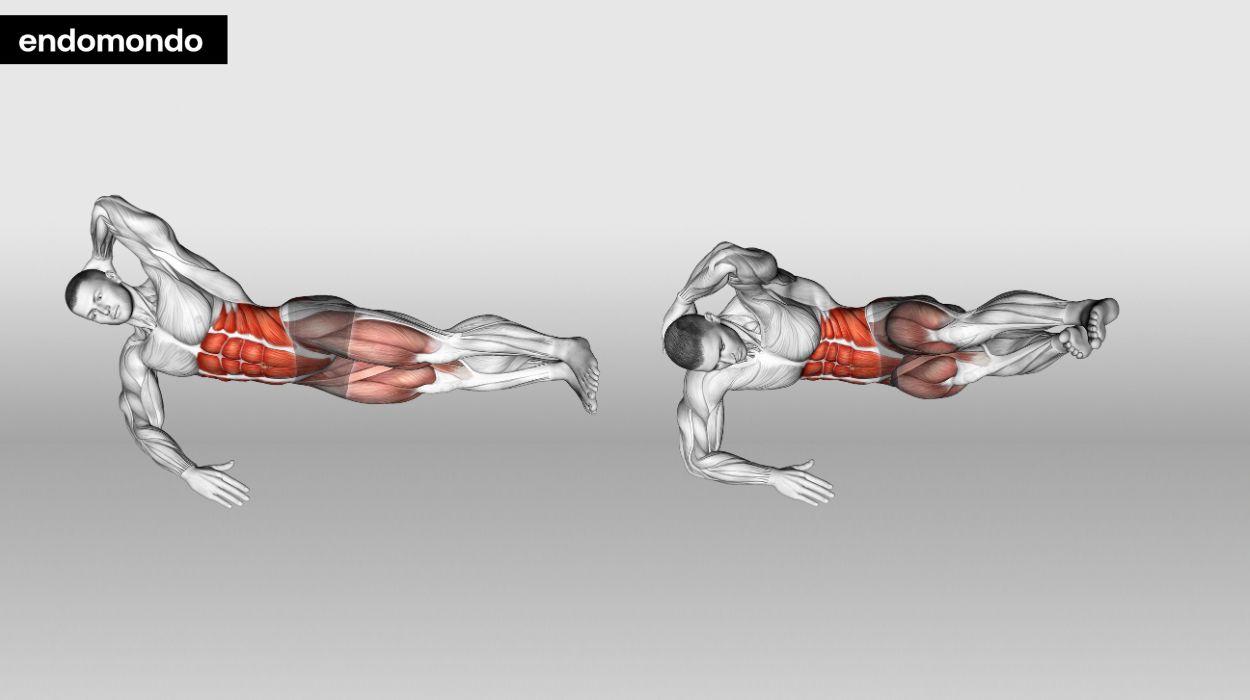
How to do:
- Lie on your right side with your legs straight and stacked on top of each other – left leg on top of the right leg. Rest your right single leg straight arm on the floor for support, and place your left arm above you, with the hand behind your head.
- Keeping your legs pressed against each other, lift your legs up off the floor and bring your left elbow toward your left knee while contracting your obliques.
- Slowly lower your legs and torso back to the starting position.
- Repeat the movement on the other side.
Tips:
- Maintain proper alignment by keeping your head, shoulders, and legs off the ground during the movement.
- Focus on quality over quantity, ensuring each repetition is performed with proper form.
- Keep your lower back on the ground during the exercise to avoid straining your spine.
Optimal Sets and Reps: 3 sets of 12-15 repetitions per side.
Weighted Plank
There are many plank variations, but the Weighted Plank is one of the most intense. This exercise adds resistance, creating a demanding exercise for the entire core.
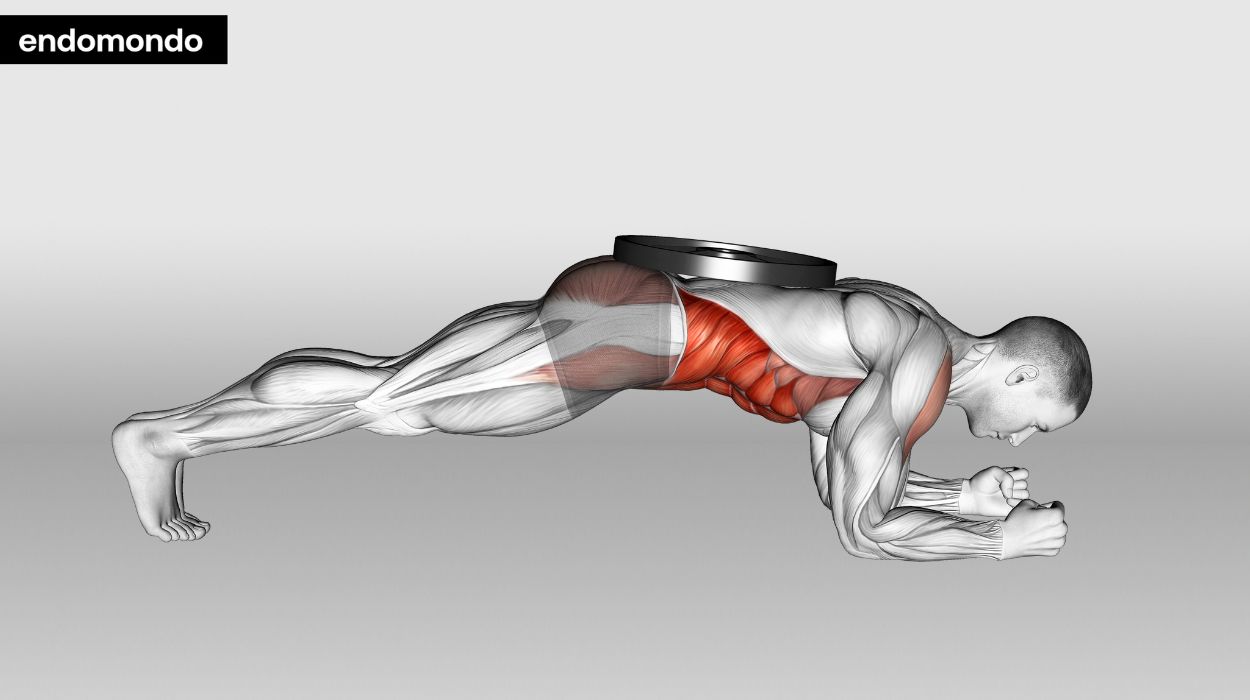
How to do:
- Assume a plank position with your forearms on the ground, elbows under your shoulders, and toes on the floor. Place a weighted plate or a dumbbell on your upper back.
- Engage your core, keeping your body in a straight line from head to toe.
- Hold the position for a specified time, such as 30 to 60 seconds.
- Remember to breathe and maintain proper form throughout the exercise.
Tips:
- Choose a weight that challenges you but allows you to maintain proper form throughout the exercise.
- Focus on your breathing, inhaling deeply through your nose and exhaling slowly through your mouth to stay relaxed.
- Keep your shoulders directly over your elbows and wrists to distribute the weight evenly.
Optimal Sets and Reps: 2-3 sets, gradually progressing to one to 2 minutes per set.
Human Flag
The Human Flag is an incredibly challenging exercise that targets the core and requires significant upper-body strength and stability. It involves holding your body horizontally while gripping a vertical pole or bar.
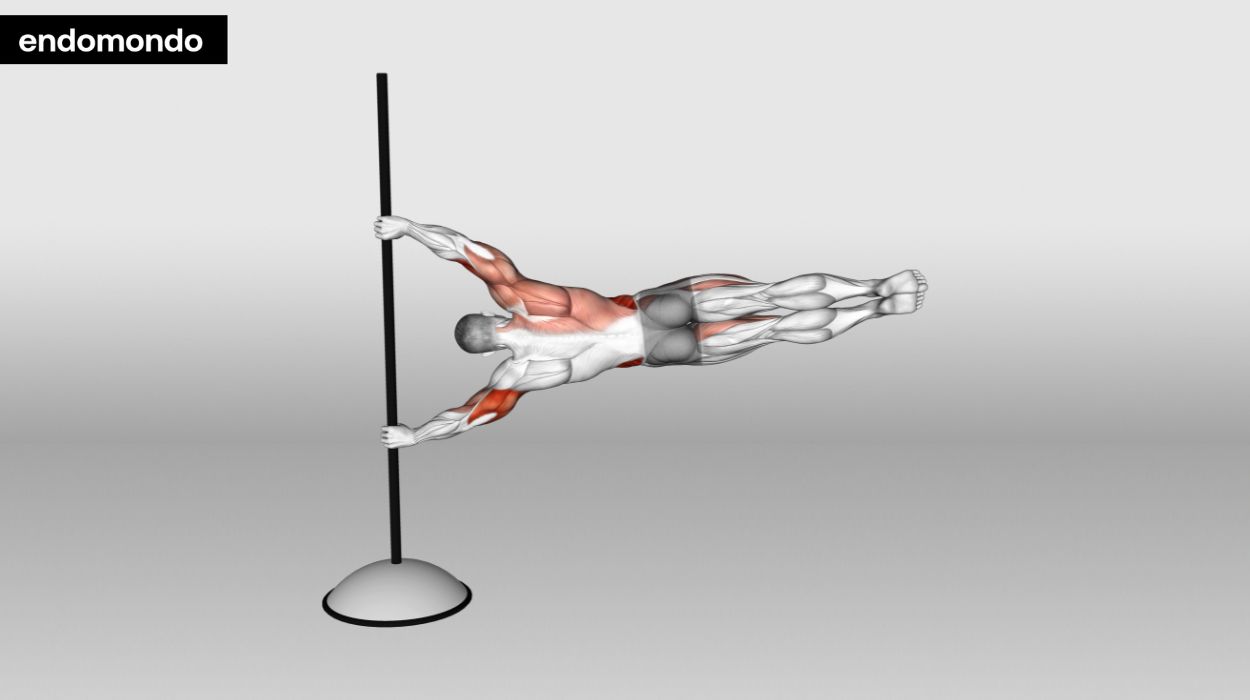
How to do:
- Stand next to a sturdy vertical pole or pull-up bar and grip it with one hand above your head and the other hand lower down.
- Engage your core and lift your feet off the ground, extending your body horizontally.
- Keep your body tight and straight, with your lower arm pushing down on the pole for stability.
- Hold the position for as long as you can maintain proper form and control.
Tips:
- Build strong core and upper body strength before attempting this advanced move.
- Ensure a secure grip and placement of your hands and arms on the horizontal bar.
- Practice with a spotter or safety harness to prevent falls and injuries during initial attempts.
Optimal Sets and Reps: 3-4 sets of 10-15 seconds hold on each side, and progress gradually.
Common Mistakes When Doing Hardest Core Exercises

Sacrificing Form For Quantity
When doing ab exercises, focus on quality over quantity. It can be tempting to rush through the movements, but rushing can increase the risk of injury.
To maximize the benefits of upper ab workouts and others, maintain proper technique throughout each movement. Slow down, engage the targeted muscles fully, and ensure controlled and deliberate execution.
Neglecting Warm-Ups
Don’t skip warm-ups before ab workouts. A proper warm-up routine[1] helps prepare your core and activate the targeted muscles, increasing blood flow and flexibility.
Prioritize dynamic stretches and light cardiovascular activity to warm up your body and loosen up your muscles. A few stretches can maximize performance and prevent injuries during lower ab workouts, general ab workouts, or any workout.
Ignoring Warning Signs
Feeling uncomfortable when you’re pushing yourself is normal, but serious pain could be a sign that something is wrong. Listen to your body. If you feel severe pain, sudden discomfort, or joint instability, stop immediately – pushing through pain can aggravate existing injuries or lead to new ones.
Pay attention to exhaustion, too. Start thinking about your nutrition if you feel like you can’t make it through a workout, especially repeatedly.
You might even consider supplements for extra protein and nutrients and to aid weight loss. It’s also possible your workout is just too intense, and you might need to tone it down a bit.
Safety Tips For Hardest Ab Workout
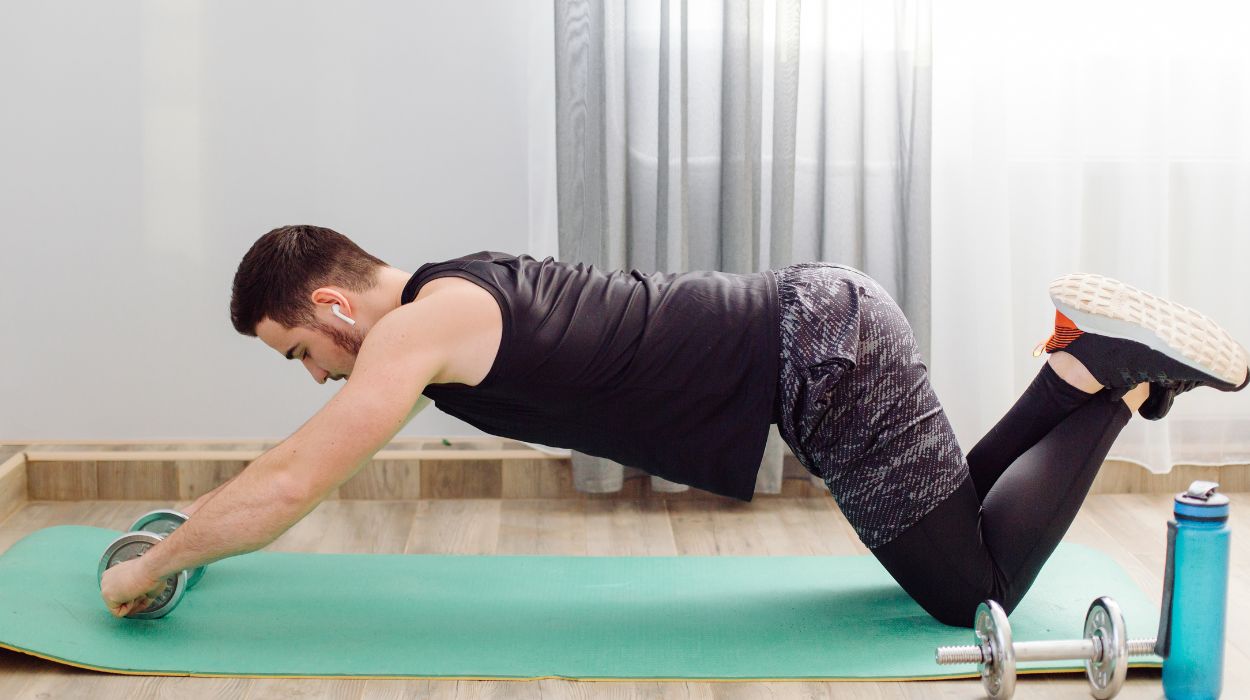
Here are some safety tips to remember:
- Start with proper warm-up exercises to prepare your core and activate the targeted muscles.
- Focus on maintaining proper form and technique throughout each exercise to prevent injuries.
- Gradually increase the intensity and difficulty of the exercises as your core strength improves.
- If you have any pre-existing medical conditions or injuries, consult with a healthcare professional before attempting these exercises.
- If you experience any sharp or prolonged pain during the exercises, stop immediately and seek medical advice.
The Bottom Line
These difficult ab exercises build a strong core, improve stability, and define abs by targeting multiple muscle groups. A beginner may want simpler core stabilization exercises,[2] but these are some of the most intense you can get.
Remember to exercise with proper form and technique to minimize injury; listen to your body and progress only gradually. Combine these exercises with a well-rounded fitness program, proper nutrients, and adequate sleep, and you’ll be unstoppable.
Frequently Asked Questions
The Dragon Flag is one of the hardest core exercises to do at home, engaging the entire core. There is no single hardest ab workout, but this one is near the top.
The effectiveness of ab exercises varies, but compound movements like the Dragon Flag, Standing Barbell Rollout, and Hanging Dragonflies are highly effective for building core strength.
Don’t work abs daily, as they need time to recover. Do abs exercises two to three times a week, and rest for at least one day in between.
Exercise two to three times a week for general fitness, but listen to your body and take breaks as needed.
Resources
- Park, H.-K., Jung, M.-K., Park, E., Lee, C.-Y., Jee, Y.-S., Eun, D., Cha, J.-Y. and Yoo, J. (2018). The effect of warm-ups with stretching on the isokinetic moments of collegiate men. [online] 14(1), pp.78–82. doi:https://doi.org/10.12965/jer.1835210.605.
- Ashiyat Akodu, Ajepe Titilope Oluwatobiloba and J.O. Onwuazombe (2020). Effects of core-stabilization and dynamic strengthening exercises on patients with non-specific chronic… [online] ResearchGate. Available at: https://www.researchgate.net/publication/350907506_Effects_of_core-stabilization_and_dynamic_strengthening_exercises_on_patients_with_non-specific_chronic_low_back_pain_in_Lagos_A_pilot_study.




